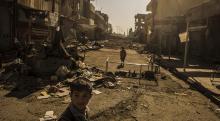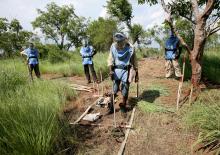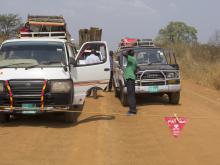Case prepared by Sadhana Sanjay and Neil Cockerill, LL.M students at Leiden University, under the supervision of Professor Robert Heinsch as well as Sofia Poulopoulou and Daniel Møgster (PhD Researcher/Researcher), Kalshoven-Gieskes Forum, Leiden University.
A. RESOLUTION ON THE PROBLEMS POSED BY THE PROLIFERATION OF ANTI-PERSONNEL MINES
[…]
RESOLUTION ON PROBLEM POSED BY PROLIFERATION OF ANTI-PERSONNEL MINES IN LIBERATED PARTS OF NEW SUDAN
The Sudan Peoples Liberation Movement and Sudan Peoples Liberation Army (SPLM/SPLA),
Deeply Concerned over the tragic consequences of indiscriminate use of Anti-personnel mines in particular and the presence of unexploded sub-munition from cluster bombs and other unexploded ordnance,
Particularly alarmed at the significant increase in the number of mines and sub-munition victims among the civil population, […]
The SPLM/A commits itself to unilateral demining efforts in the areas under its control, and hereby commissions the Operation Save Innocent Lives – Sudan (OSIL-SUDAN) as an indigenous voluntary organization to demine the liberate areas of New Sudan and to help put an end this scourge.
SPLM/A appeals to the international community to support OSIL-SUDAN in this humanitarian endeavour.
[…]
B. DEED OF COMMITMENT FOR ADHERENCE TO A TOTAL BAN ON ANTI- PERSONNEL MINES UNDER GENEVA CALL
DEED OF COMMITMENT UNDER GENEVA CALL FOR ADHERENCE TO A TOTAL BAN ON ANTI-PERSONNEL MINES AND FOR COOPERATION IN MINE ACTION
WE, the Sudan People’s Liberation Movement and Sudan People’s Liberation Army (SPLM/A), through our duly authorized representative, […]
Realising that the limited military utility of anti-personnel mines is far outweighed by their appalling humanitarian, socio-economic and environmental consequences, including on post-conflict reconciliation and reconstruction;
Rejecting the notion that revolutionary ends or just causes justify inhumane means and methods of warfare off a nature to cause unnecessary suffering;
Reaffirming our determination to protect the civilian population from the effects or dangers of military actions, and to respect their rights of life, to human dignity and to development;
Resolved to play our role not only as actors in armed conflict but also as participants in the practice and development of legal and normative standards for such conflicts, starting with a contribution to the overall humanitarian effort to solve the global landmine problem for the sake of all its victims;
[…]
Hereby solemnly commit ourselves to the following terms:
1. TO ADHERE to a total ban on anti-personnel mines. By anti-personnel mines, we refer to those devices which effectively explode by the presence, proximity or contact of a person, including other victim-activated explosive devices and anti-vehicle mines with the same effect whether with or without anti-handling devices. By total ban, we refer to a complete prohibition on all use, development, production, acquisition, stockpiling, retention, and transfer of such mines, under any circumstances. This includes an undertaking on the destruction of all such mines.
2. TO COOPERATE IN AND UNDERTAKE stockpile destruction, mine clearance, victim assistance, mine awareness, and various other forms of mine action, especially where these programs are being implemented by independent international and national organisations.
3. TO ALLOW AND COOPERATE in the monitoring and verification of our commitment to a total ban on anti-personnel mines by Geneva Call and other independent international and national organisations associated for this purpose with Geneva Call. Such monitoring and verification include visits and inspections in all areas where anti-personnel mines may be present, and the provision of the necessary information and reports, as may be required for such purposes in the spirit of transparency and accountability.
[…]
C. STATEMENT OF THE SPLM/A ON THE DEED OF COMMITMENT
[…]
As far as the issue of landmines is concerned, the SPLM/A in 1996, unilaterally, declared a moratorium on the use of landmines before the 1997 Ottawa Convention. Our move was prompted not by the desire to wash our face before the international community, or gain an undue recognition while we do the contrary. No. Our decision was triggered by the simple fact that we are fighting for a peaceful homeland and not a turbulent mine-land. And hence, to actualize our aspirations in liberating a peaceful homeland, we commissioned a humanitarian mine action in the areas under our administration. We did it contrary to what some pessimistic experts cherish, that mine action can only be undertaken at peace times, and portray the impossibility of it taking place in areas controlled by non-state actors. Today, and for the last four and a half years, Operation Save Innocent Lives (OSIL -Sudan), has been remarkably active in saving innocent lives. It has succeeded in opening up in-lets to remote areas where the needy could be reached. Displaced communities are returning to their homesteads, schools are coming up and markets revived. Having seen such positive results, do we have to wait for a political peace to be declared after which to move to save innocent lives? If it has been possible for the international community to save millions of innocent lives from famine and diseases for the past eleven years during conflict, what then would be the logic of vaccinating a child against polio for it to be maimed or killed a day or moments after by a mine?
[…] As we stand committed to deposit our Deed of Commitment, we raise our voice to the international community to bring pressure to bear on the government of the Sudan to ratify the Ottawa Convention on the ban on the use of landmines and to allow free access for co-ordinated cross-conflict mine action operations. Indeed, states and their affiliated militia should not be allowed to abuse humanity in the name of sovereignty.
[…]
D. INTERNATIONAL ACTION AND COOPERATION
[…]
New mine action activities launched
In several countries, particularly in Sudan […], the signing of the Deed of Commitment facilitated the launch of much-needed humanitarian mine action activities by specialized organizations in areas under the signatory NSAs’ control.
In Sudan, Geneva Call facilitated contacts between the SPLM/A and mine action stakeholders, which resulted in a landmark tripartite Memorandum of Understanding (MoU) signed in 2002 between the Government of Sudan, the SPLM/A and UNMAS. This MoU for UN emergency mine action support to Sudan, together with the improving political situation and the 2002 ceasefire agreements, helped to expand mine action activities, especially in the south. According to mine action operators, the signing of the Deed of Commitment by the SPLM/A also facilitated the release of funds as many donors made their support conditional on a mine ban.
[…]
Challenges
Both SPLM/A and MILF [Moro Islamic Liberation Front] leaders have revealed the difficulties they have faced in getting their rank and file to accept their decision to ban AP [anti-personnel] mines. Some field commanders still considered mines as legitimate weapons in certain circumstances (self-defence, for example) and invoked military arguments in favour of continued use. Typically, armed groups face superior conventional armed forces, which can make it difficult for their rank and file to agree to renounce any means of warfare. Similarly, the level of control enjoyed by some signatory leaders over their fighters appeared to be limited, thus raising questions as to their ability to secure full compliance with the Deed of Commitment. A related challenge has been the practical difficulties for some signatory groups, such as the SPLM/A, in disseminating their ban policy over the vast and remote areas under their control. The SPLM/A conceded that, although it had not found any instance of violations, there may have been limited use of AP mines by some fighters due to a lack of awareness of the new policy. That is why the leadership requested Geneva Call to assist in its dissemination efforts by conducting workshops on the Deed of Commitment for its rank and file.
[…]
The early engagement of UNMAS in emergency mine action assistance in Sudan was influenced by the UN mine action policy […] and was in accordance with a General Assembly Resolution on Emergency Assistance to the Sudan […]. The details of the UN emergency mine action project were agreed upon in a memorandum of understanding between the GoS [Government of Sudan], SPLM and the UN in 15 September 2002.The memorandum of understanding was significant in a number of ways:
• it was the first “state-wide” document that the main conflicting parties (GoS and SPLA/M) signed
• it prepared the ground for pre-CPA [Comprehensive Peace Agreement] peace negotiations
• it was instrumental for the inclusion of important mine action aspects in the subsequent CPA
As an operation partner of the JMC [Joint Military Commission], the Danish Church Aid (DCA) implemented the first cross-border demining activities in the Nuba Mountains in 2002. These first clearance activities were unique, in the sense that the clearance team was composed of equal numbers of deminers from each side of the two main conflicting parties, northern and southern Sudan. The national organisations, JASMAR [Sudanese Association for Combating Landmines] from northern Sudan, and Operation Save Innocent Lives (OSIL) from southern Sudan, initiated an operational partnership, with direct supervision by the DCA.
[…]
E. FROM THE DEED OF COMMITMENT TO THE OTTAWA CONVENTION
[…]
In depositing its notification of succession to the United Nations 11 November last, the Republic of South Sudan has become the 158th State Party to the Anti-Personnel Mine Ban Convention, commonly known as the Ottawa Convention.
“We congratulate the new Government of South Sudan for having taken this commitment, only five months after declaring independence”, said Elisabeth Decrey Warner, President of Geneva Call. “We know that the leaders of South Sudan, when they were engaged in armed opposition, were already concerned by the effects of landmines on their people and decided as early as 2001 to renounce the use of anti-personnel mines […]. The Sudan People’s Liberation Movement/Army (SPLM/A) was one of the first armed non-State actors to sign the Geneva Call Deed of Commitment for Adherence to a Total Ban on Anti-Personnel Mines and for Cooperation in Mine Action […]. South Sudan’s succession to the Ottawa Convention today is in continuity with this humanitarian spirit […]”.
[…] The SPLM/A fought against the Sudanese Government from 1983 to 2005 and is today the ruling party in South Sudan.
Indeed, the signing of the Deed of Commitment by the SPLM/A in 2001 was key in the Sudanese Government’s decision to ratify the Ottawa Convention in 2003. According to Martin Barber, at the time Director of the United Nations Mine Action Service, “Sudan would not have felt able to ratify the Treaty if the SPLM/A had not already made a formal commitment to observe its provisions in the territory under its control.”
[…]
Discussion
I. Classification of the Situation and Applicable Law
1. (Documents A, B, C and D) How would you classify the situation in Sudan at the time when the SPLM/A adopted the Resolution? When it signed the Deed of Commitment? Did it amount to an armed conflict? What additional information would you require in order to make such a determination? Was SPLM/A bound by IHL? (
GC I-IV, Art. 3)
2. (Document E) Did the status of SPLM/A change when South Sudan became an independent State in 2011? How? Is South Sudan bound by IHL?
II. Anti-Personnel Mines and Demining Action
3. Are anti-personnel mines
per se unlawful under IHL? In what circumstances would the use of anti-personnel mines constitute an unlawful method of warfare? Which other treaties govern the usage (or non-usage) of anti-personnel mines? (
P I, Arts 35,
51;
CIHL, Rules 1,
11,
12,
70,
71,
81,
82 and
83;
Ottawa Convention;
Protocol II to the CCW on prohibitions or restrictions on the use of mines, booby-traps and other devices, as amended in 1996)
4. (Documents A and B) What is the legal value of the Resolution adopted by the SPLM/A and of the Deed of Commitment and how can such instruments bind non-state actors?
III. Elements Contributing to Respect for IHL
6. (Documents A and B) Why you think it may be important for armed non-state actors to demonstrate “their determination to protect the civilian population” and the willingness to alleviate their suffering? In your opinion, did the statehood aspirations of the SPLM/A impact its decision to issue the Resolution in 1996 and sign the Deed of Commitment in 2001 and to take practical steps to implement them?
7. (Document B) The Deed of Commitment of the SPLM/A rejects the idea that the “revolutionary ends or just causes” can justify resort to practices that may violate IHL. In your opinion, can violations of IHL have a negative impact on the cause armed non state actors are fighting for?
8. (Document B) Do you think the “limited military utility” of anti-personnel mines played a role in SPLM/A committing itself to adhere to a total ban on the use of anti-personnel land mines? Why?
9. (Document B) In your view, can the signature of a Deed of Commitment by an armed group and its implementation contribute to the other armed groups’ compliance with IHL? Can armed groups serve as role models in proving that respect for IHL does not preclude success of their military goals?
10. (Document C and E) Do you think that by adhering to the ban on the use of anti-personnel mines SPLM/A had an expectation that the Government of Sudan would do the same? Do you agree that the ratification of the Ottawa Convention by the Government of Sudan in 2003 may have been influenced by the actions of the SPLM/A? Can positive reciprocity contribute to the respect for IHL by the adversary? What could have been the reputational cost for the Government of Sudan in the eyes of the civilian population if it did not adhere to the ban when the SPLM/A did so? In your opinion, how can “international pressure” influence the behaviour of the fighting parties?
11. (Document C and D) According to SPLM/A they are “fighting for a peaceful homeland and not a turbulent mine-land”. In your opinion, what do they mean by that? Is there a link between the respect for IHL and peace building in post-conflict environments? Do you think that in addition to political considerations, economic factors may also influence the parties to the conflict to refrain from certain practices that may violate IHL?
12. (Document D) Mine action operators have observed that the signing and implementation of the Deed of Commitment by the SPLM/A played an important role in “the release of funds” and that “many donors made their support conditional on a mine ban”. Do you think that the interest of the SPLM/A to have the territory under their control cleared out of mines may have influenced its decision to adhere to the ban?
13. (Document E) Do you agree that the SPLM/A’s adherence to the mine ban during the opposition contributed to South Sudan’s succession to the Ottawa Convention following its independence? Why?






